If there is a fire in a building you exit through the fire escape. The only problem, in the early 1900s, the fire escapes as we know them today didn't exist in most buildings and entrepreneurs were working hard on solutions.
One such inventor was Pasquale Nigro who in 1909 patented a fire escape, Patent #912,152. Pasquale's fire escape was a pair of escape-wings that in his own words from his patent "...the frame is placed on the wearer's shoulders...the wearer engages the loops with his hands and is prepared to leap [from a building], the air imprisoned beneath the fabric material serving to up-hold the wearer and break the force of his fall..." Terrifying at best, serious injury for sure, deadly likely, leaping from a building with wings seems like an unlikely product-market-fit type of solution. I imagine testing of the prototype was short and conclusively exposed the product weaknesses.
So why do inventors incur the expense of patenting before you know if there is a market for their product?
The short answer is timing. Inventors tend to want to protect their ideas as early as possible. With many worries, inventors are often concerned about others patenting their idea and business partners stealing their idea.
Maybe the better question to ask might be how can the cost of patenting be deferred until I know I have a good product-market-fit. The answer to this question is a patent strategy that might include:
- Bootstrap patent and file a provisional patent. If your an inventor that is willing to provide a good first draft description of your idea it can be polished and filled on a shoestring budget for a couple of hundred dollars, saving your patenting budget for later. The provisional patent records the filing date and afford 12 months of patent pending status.
- Build and test a prototype and assess product-market-fit during the year of provisional patent protection.
- Use your patenting budget wisely to protect your product. At a medium cost, convert your computer-aided design (CAD) figures into a design patent to protect 'how your product looks' and/or convert your provisional patent work into a non-provisional patent application at a higher cost that protects 'how your product works'.
Ways we can help you:
-
-
- Drafting, filing, and prosecuting patent applications
- Embedding with innovation teams to harvest, refine, and protect ideas
- Identifying patentable ideas within startup technologies
- Landscaping markets to identify new opportunities
- Developing patent strategies for products and startup
- Managing the patent creation process from concept to product launch
- Searching ideas for prior art patents
- Reviewing prior art patents with product development teams
- Building IP for VC/PE portfolio companies
-
Learn more at www.Gr8BigIdeas.com
#patents #patentengineering #startups #entrepreneurs #breakthrough #intellectualproperty #corporateinnovation #innovation


